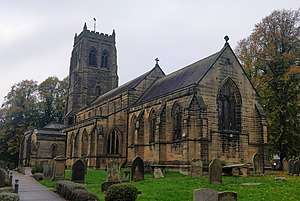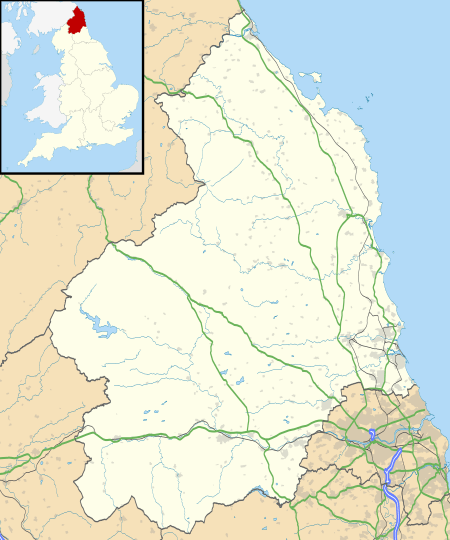Stannington, Northumberland
Stannington is a small village in central Northumberland which is associated with Morpeth and its county council. The population of the civil parish was 1,219 at the 2001 Census, increasing to 1,280 at the 2011 Census.[2] Stannington is divided into three: Stannington North-East Quarter, Stannington North-West Quarter and Stannington South Quarter. The total area of Stannington, including Stannington Vale, is 10,093 acres (40.84 km2).
| Stannington | |
|---|---|
 St Mary's Church | |
 Stannington Location within Northumberland | |
| Population | 1,219 (2001 census)[1] |
| OS grid reference | NZ215795 |
| Unitary authority | |
| Ceremonial county | |
| Region | |
| Country | England |
| Sovereign state | United Kingdom |
| Post town | MORPETH |
| Postcode district | NE61 |
| Dialling code | 01670 |
| Police | Northumbria |
| Fire | Northumberland |
| Ambulance | North East |
| UK Parliament | |
Buildings
St Mary's church
Stannington's oldest building is the church, St. Mary The Virgin. The original church on that site dates back to 1190AD.
Most of the current church was constructed in 1871, to a design by R J Johnson of Newcastle, at a cost of £6,000.[3] It incorporates the 13th century north arcade of the medieval church, and some medieval stained glass and grave covers.[4]
The old vicarage, built in 1745, stands near the church, with the current vicarage behind.[5]
Hospitals
There were two hospitals in the village. Stannington Children's Hospital was the first children's tuberculosis hospital in the country; St. Mary's Hospital was an asylum originally known as the Gateshead Lunatic Asylum. Both are now closed.[3] One former hospital north-east of the village near Netherton was built in the 1930s and featured the Thomas Taylor retirement homes for Wansbeck residents. Behind the main complex was the Mona Taylor Maternity Hospital which was named after the leading suffragist, Mr Taylor's wife. Many children were born here until it too became an old people's home and, together with the rest of the site, was then owned by Northumberland County Council. Today this development is known as Hepscott Park with some original hospital buildings surviving in local authority use, other buildings converted into private homes and some additional new houses.
Other buildings
Stannington First School is located near the church. The village also has a post office.
Other listed buildings in the village include two bus shelters, built in 1937 to a design by Laurence Whistler and presented to the village by Lord Ridley in commemoration of the coronation of King George VI.[6]
Transport
The A1 road arcs past the village and in instances of traffic accidents or otherwise-motivated road closures, traffic from the A1 has been diverted through the village. This section of the A1 was substantially rebuilt with two new roundabouts and new junctions in 2003 and 2004 following a fatal accident in 1999.[7]
In 1847 a railway station was opened near the village. Initially known as Netherton, it was renamed to Stannington in 1892, but passenger services ended in 1958 and the station finally closed to goods trains too in 1964.[8]
References
- Office for National Statistics: Neighbourhood Statistics
- "Civil Parish population 2011". Retrieved 30 January 2016.
- Northumberland Communities - Stannington
- Historic England. "Church of St Mary the Virgin, Church Road (Grade II) (1042627)". National Heritage List for England. Retrieved 22 October 2019.
- Historic England. "The Old Vicarage (Grade II) (1025120)". National Heritage List for England. Retrieved 22 October 2019.
- Historic England. "Bus shelter 45 metres north of footbridge (Grade II) (1042661)". National Heritage List for England. Retrieved 22 October 2019.
- A1 re-opening at Stannington next month - Morpeth Herald
- Stannington Station northumbrian-railways.co.uk
External links
| Wikimedia Commons has media related to Stannington, Northumberland. |
- GENUKI (Accessed: 5 November 2008)
- Stannington First School Website